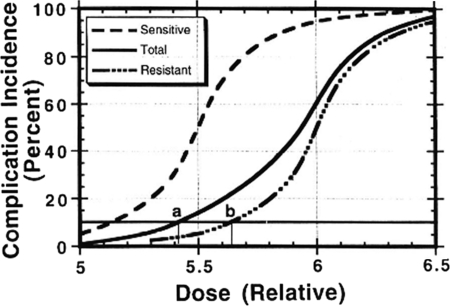Figure 3.
Altering dose on the basis of an individual patient's sensitivity to toxicity can affect the therapeutic ratio. Dosing of chemotherapy or radiation is based on sensitivity to toxicity that is based on population averages (solid line). In reality, any population also contains individuals that will be either more sensitive (dashed line) or more resistant (dot-dash line) to treatment toxicity than the average population. The sensitive patients, which probably comprise ≤5%–10% of the overall population [1, 2], nonetheless drive the dosing schemes. In this example, by holding the acceptable complication incidence at 10%, a resistant patient (b) could receive an approximately 5% greater dose than an average patient (a) and a 10% greater dose than a sensitive patient. Dose differences of this magnitude have been associated with differences in outcome.

